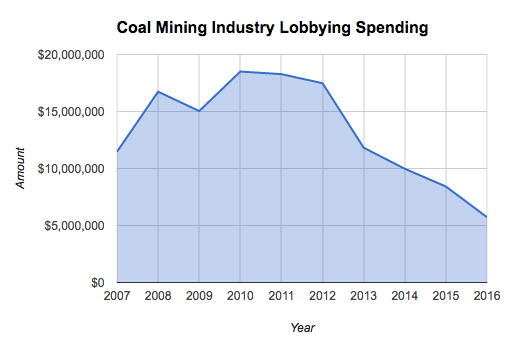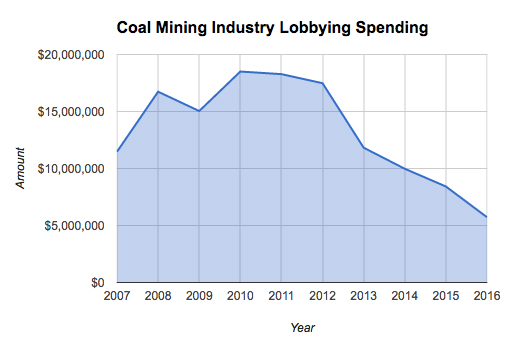
President Donald Trump wasted little time attending to one of his constituencies: Less than a month after taking office, and surrounded by applauding coal miners and a few friendly members of Congress, he put the knife in an Obama-era regulation barring coal mine waste from being dumped in waterways.
And Trump is said to have more coal-friendly executive orders lined up, including one to relax limits on greenhouse gas emissions from power plants and reverse a temporary ban on federal coal leases.
Indeed, Trump is proving to be a worthwhile investment for an industry that contributed far more to getting him elected than to any other presidential hopeful. Trump’s campaign took in $240,000 from employees or PACs of coal companies. That’s more than double the $104,000 that the second-highest recipient, Texas Sen. Ted Cruz (R), raked in.
If that doesn’t sound like much, here’s some real money: $1.1 million given to the pro-Trump outside spending groups Future45 and Rebuilding America Now.
Some of that coal cash has been controversial, especially as major players in coal production recently have faced large layoffs or declared bankruptcy: Last year Murray Energy’s PAC gave $100,000 to Trump’s joint fundraising committee on June 28, the day before sending 4,400 layoff notices to workers. Most of those particular layoffs didn’t happen in the end, but there have been others: In May 2015, Murray’s workforce stood at 8,400; as of December 2016, it was down to 6,000. More than 400 employees of an Ohio subsidiary, the Ohio Valley Coal Co., lost their jobs or were transferred last November when the Powhatan No. 6 Mine shut down due to lack of reserves.
Nevertheless, using its corporate coffers and its PAC, Murray Energy donated a total of $1.5 million to political candidates, party committees and outside groups in the 2016 cycle, a record high for the company. It gave $250,000 to the Cleveland Host Committee, which helped fund the Republican National Convention this year, and $200,000 to pro-Trump super PAC Rebuilding America Now.
And Trump’s campaign received almost $103,000 from Murray Energy employees.
Trump was the largest beneficiary by far of the mining company’s gifts, but there were others: New Day for America, a 527 committee backing Ohio Gov. John Kasich, received $300,000; the pro-Sen. Mark Kirk (R-Ill.) super PAC Independent Voice for Illinois got $129,000; and the conservative Citizen SuperPAC received $110,000, which went toward backing congressional candidates such as Sen. Richard Shelby (R-AL) and Sen. Ted Cruz (R-TX).
The company minced no words explaining its efforts.
“Given that virtually all Democrats support the elimination of coal mining in the United States, and the thousands of jobs the industry provides, and that Hillary Clinton publicly stated that she was ‘gonna put a lot of coal miners and coal companies outta business,’ Murray Energy Corporation had no choice but to support those politicians who have vowed to protect and defend the United States coal industry,” said Gary Broadbent, Murray’s senior corporate counsel, in an email to OpenSecrets Blog.
(Clinton, the Democratic presidential nominee, did make that statement, but in the same speech spoke about revitalizing coal communities and later released a plan to retrain workers.)
Murray set the high mark, but one other coal company — which has its own difficulties — stood out for its efforts.
Alliance Resource Partners, the third-largest producer of coal in the East, announced 275 layoffs in February 2016, partly due to what it said were “overreaching regulations.” The organization’s PAC spent $126,000 this cycle, its most modest showing since 2008.
But Alliance employees contributed $3.4 million in the 2016 cycle, up from 2014. Alliance CEO Joe Craft gave $750,000 to pro-Trump Future45, and, through his personal trust, gave $1 million to anti-Clinton super PAC American Crossroads and $100,000 to the pro-Mitch McConnell group Kentuckians for Strong Leadership, which spent its funds against Clinton this year. (The company has operations in Kentucky, though it is headquartered in Tulsa, OK) The latter received more backing from other Alliance employees, with $100,000 from Charles Wesley, the executive vice president, and $10,000 from Thomas Wynne, COO and senior vice president.
Still, if Murray and Alliance led the pack in donations from a declining industry, five other coal mining firms managed to donate thousands through their PACs despite filing for bankruptcy in the past couple of years. Their outlays, though, were substantially smaller than in past cycles.
Peabody Energy PAC gave $78,000, its smallest total since 1998, donating $10,000 to House Majority Leader Kevin McCarthy (R-Calif.), $7,500 to Sen. Lisa Murkowski (R-Alaska) and $6,000 to the Republican National Committee. Frederick Palmer, the senior vice president of government relations of the St. Louis-based company, gave $11,000 to an assortment of Missouri lawmakers and $2,700 to the presidential bid of Ohio Gov. John Kasich (R).
Alpha Natural Resources PAC gave $15,000 each to the NRCC and NRSC, the party committees dedicated to electing Republicans to the House and Senate. The PAC gave out a total of $203,000, the least since 2008. Employees donated a mere $10,000 this year, compared to $169,000 in 2014 and $321,000 in 2012.
Arch Coal’s PAC gave $328,000 in the 2016 campaign; as with Alpha, this was Arch’s smallest total since 2008, doling out $30,000 to the NRCC and $20,000 to the RNC. Employees gave $9,000 in donations (compared to $137,000 in 2012).
And Patriot Coal’s PAC gave $2,300 to West Virginia reps; employees contributed $59,000, all to Republicans.
Walter Energy PAC gave $4,500 in total to Reps. Barr (R-KY) and Jenkins (R-WV) — way down from the $62,000 it contributed in 2014. No employees made political contributions this year.
Coal Lobbying Hits a Wall
While Murray Energy gave out more to politicians than ever before, its lobbying spending dipped to about $350,000 — roughly one-third of its 2011 peak of $1 million. The company lobbied to support bills to protect health care benefits and pensions for coal industry workers. The Miners’ Protection Act would move billions of dollars from the Abandoned Mine Reclamation Fund into health care and pension plans for the United Mine Workers of America. Congress temporarily extended retired miners’ plans late last year. The stopgap expires April 18, and congressional Democrats, led by Sen. Joe Manchin (D-WV), threatened to stall approving a waiver for Robert Lighthizer, Trump’s U.S. trade representative nominee, unless lawmakers extend it.
But given that it made substantial political contributions using corporate funds, Murray clearly made a choice: That same money could have been used to lobby Congress on the issues it cared most about. Instead, it tried to keep another Democrat from occupying the Oval Office. Murray’s involvement in presidential politics isn’t new: In 2012, miners at a company facility in Ohio said they were forced to attend a rally for GOP candidate Mitt Romney and weren’t paid for their time. The FEC dropped its investigation of the incident in 2015.
The industry as a whole has followed Murray’s pattern of spending less and less on lobbying in recent years. Peak outlays came around 2010 and 2011 as the number of jobs began to tank. Last year marked the lowest spending by the coal industry since 2004. Peabody Energy, which filed for bankruptcy protection last April, logged the highest lobbying spending in the industry at $1.8 million — but that was the smallest amount the company has spent since 2004. The company peaked in 2008 with $8.4 million in spending.

Trump called the reg he struck from the books — the Office of Surface Mining’s Stream Protection Rule — “another terrible job killing rule,” saying he was keeping his campaign promise to save miners’ jobs.
It’s true there are fewer jobs in coal: From 89,500 coal mining jobs at the end of 2011, the figure had sunk to 50,100 as of Jan. 2017, according to the Bureau of Labor Statistics. And while tighter regulations to help protect the environment are definitely a piece of the puzzle, so are cheaper energy alternatives such as natural gas, as well as increased automation of mining jobs.
“That’s all because there has been a rise in citizen advocacy as communities across the country push to move beyond coal to clean energy while competition in the marketplace intensifies,” said Mary Anne Hitt, the Director of Sierra Club’s Beyond Coal Campaign, in an email to OpenSecrets Blog. “That is not going away no matter who is in the Oval Office.”
Doug Weber and Alex Baumgart contributed to this post.
Join us in defending the truth before it’s too late
The future of independent journalism is uncertain, and the consequences of losing it are too grave to ignore. To ensure Truthout remains safe, strong, and free, we need to raise $43,000 in the next 6 days. Every dollar raised goes directly toward the costs of producing news you can trust.
Please give what you can — because by supporting us with a tax-deductible donation, you’re not just preserving a source of news, you’re helping to safeguard what’s left of our democracy.